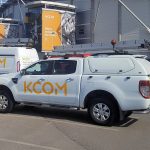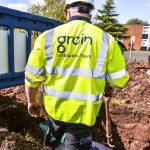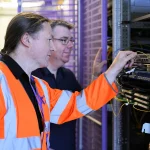BT – FTTP Broadband Covers 631K UK Premises and G.fast 1.12M
BT has published their latest results to the end of June (Q1 2018/19 financial), which report that the coverage of Openreach’s “ultrafast broadband” (100Mbps+ via FTTP and G.fast) network has reached 1.7 million UK premises. But sadly they’ve begun hiding their retail ISP customer figures.
Since the last set of financial results there have been a number of developments for BT. Firstly, they announced a new range of converged fixed line broadband and mobile products (here), which partly relates to their goal of delivering a “single integrated all-IP fibre network” that will enable seamless converged access across fixed, WiFi and mobile services (here).
On top of that they’ve announced the departure of CEO Gavin Patterson (here) and recently passed Ofcom’s first test of Openreach’s progress toward independence (here). But they’ve also been fined £77k for unlawfully sending 4,930,141 spam emails (here), have hit consumers with yet another price hike (here), announced the next batch of UK areas to receive G.fast broadband technology (here) and cut wholesale FTTx prices (here).
Advertisement
However one of the most frustrating changes this quarter is the decision by BT to hide the customer figures for their retail broadband base, which is no doubt partly due to the previous quarterly decline of -3,000 (unlikely to be helped by the recent price hike). ISPs that suffer a subscriber decline tend to stop reporting related figures, until they improve.
Otherwise BT are no doubt busy digesting what Ofcom and the Government’s new full fibre broadband strategy will mean for their position in the market (here and here).
Financial Highlights – BT’s Quarterly Change
* BT Group revenue = £5,715m
* BT Group reported profits before tax = £704m
* BT Group total net debt = £11,227m
As usual BT also includes an update on their capital expenditure and clawback (gainshare) from the government’s Broadband Delivery UK roll-out programme (i.e. this funding can be reinvested by local authorities to boost coverage: details), but under the new format they no longer seem to give a firm financial figure (in the previous quarter it was £536m).
BT’s Capex
Capital expenditure was £839m (Q1 2017/18: £835m) including fixed network investment of £428m, down 1% due to lower mobile investment under ESN. Other capital expenditure components were up 2% with £224m spent on customer driven investments, £150m on systems and IT, and £37m spent on non-network infrastructure.
Under the terms of the BDUK programme, we have an obligation to repay or re-invest grant funding depending on factors including the level of customer take-up achieved. Our base-case assumption for take-up in Broadband Delivery UK (BDUK) areas has increased to 43% of total premises passed. We will continue to assess this each quarter.
So far the new results format seems to be missing a lot of key data. We do however note that 65.6% of their BT retail broadband ISP base now takes a “superfast broadband” connection, while just 0.3% had adopted one of the new “ultrafast broadband” (FTTP and G.fast) based services; unsurprising given the limited coverage and promotion.
Advertisement
However one positive of the new format is that Openreach are offering a much more useful breakdown of their fixed line network reach and take-up by technology.

We expected the G.fast rollout to be going a lot faster than this in the last quarter, so it’s surprising they haven’t delivered more. The pace will need to ramp up if they’re to hit the target of 10 million premises passed with G.fast and 3 million with FTTP by 2020, although FTTP is going reasonably well with c.10,000 premises per week being built.
Speaking of FTTP, we note that some 194,000 out of 631,000 covered premises have connected to the service, which suggests a strong take-up of 30.74%. However this figure may slip as the roll-out gathers pace since take-up tends to lag behind new deployments (i.e. it grows organically / more slowly over time).
Advertisement
Gavin Patterson, Outgoing CEO of BT Group, said:
“We’ve made a good start to the year. We are making positive progress against our strategy. Our customer experience metrics continue to improve and we have seen the successful launch of new converged products including BT Plus, our first Consumer converged offering and 4G Assure, for business customers. Initiatives to transform our operating model have seen a gross reduction in c.900 roles across the Group and improved cost performance.
EE continues to maintain its network leadership and will switch on the UK’s first live 5G network trial in October. Openreach continues its FTTP network deployment and is currently building to c.10,000 premises per week. New Openreach wholesale pricing will incentivise communications providers to encourage more of their customers onto better services and ultimately move the vast majority of Britain’s homes and businesses onto superfast and ultrafast platforms. We welcome the initial outcome of DCMS’ Future Telecoms Infrastructure Review and Ofcom’s approach to future regulation and look forward to further engagement with all our key stakeholders to ensure greater clarity, certainty and support as we look to realise our broader investment ambitions.
Our outlook for the year remains unchanged.”
Finally, in terms of 4G mobile coverage, it’s notable that BT has this time chosen to only report EE’s population coverage figure of “over” 98% and not a geographic figure. Previously they made a big song and dance (“Clear on coverage“) about the geographic figure being much more important and how they would now only focus upon that, which is brushed under the carpet in today’s report.. along with their customer figures.
In the previous update BT reported that EE’s geographic (landmass) 4G network coverage of the United Kingdom was 90% (the same as last quarter) and that they aimed to cover 95% by the end of December 2020. Hopefully that target is still intact.
On the whole this quarter has seen BT join the likes of Sky Broadband and TalkTalk in becoming annoyingly vague with some of their key figures, which have been swept under the carpet to avoid criticism. In the future we’ll thus have to rely on third-party estimates by market analysts.
UPDATE 10:59am
We’ve asked EE about the 4G mobile coverage figure and have been told in no uncertain terms that BT Group made an error by publishing the out-of-date 98% population figure. EE said they still only intend to publish figures for geographic coverage and that hasn’t changed. The operator further added that 95% geographic coverage remains the ambition and they’re currently at 91% (up from 90% in the previous quarter).
Mark is a professional technology writer, IT consultant and computer engineer from Dorset (England), he also founded ISPreview in 1999 and enjoys analysing the latest telecoms and broadband developments. Find me on X (Twitter), Mastodon, Facebook, BlueSky, Threads.net and Linkedin.
« Shetland Prep Second Attempt at £2m Full Fibre Broadband Bid
Sky UK Cuts £50 Off FTTC Broadband and Phone Setup Fee »

















































Comments are closed